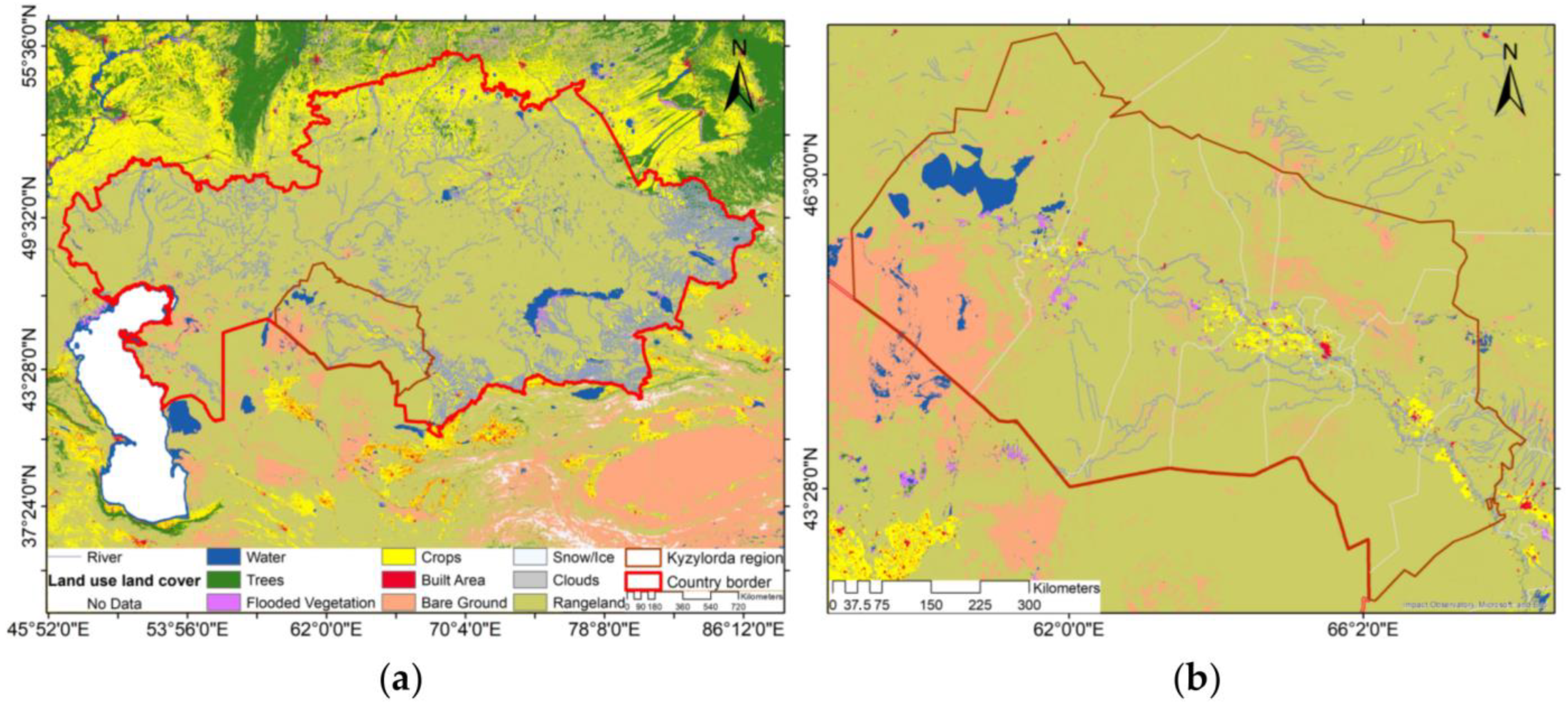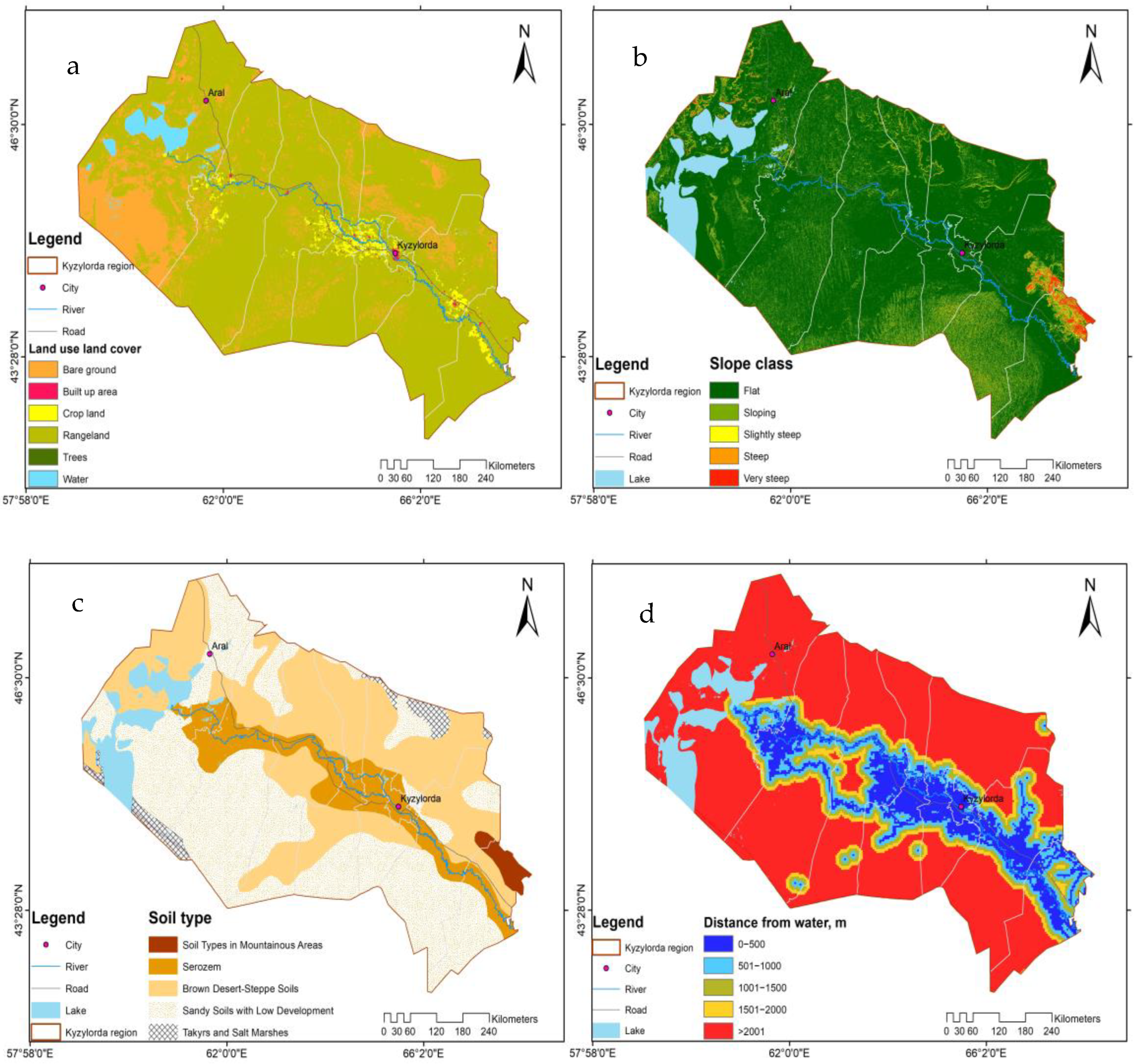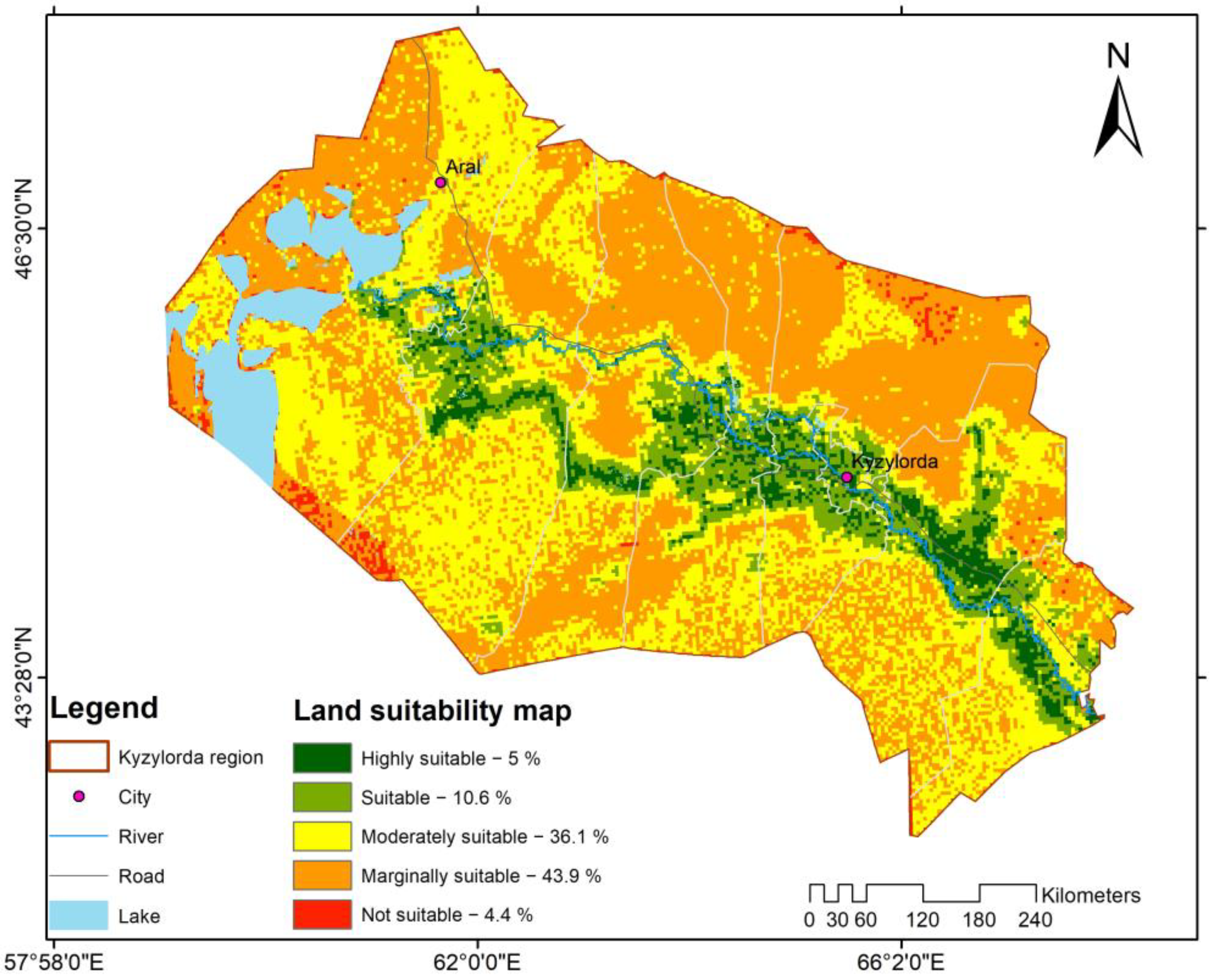Geospatial Technology Utilization for Evaluating Land Suitability for Irrigation
Abstract
1. Introduction
1.1. Brief Literature Review
1.2. Study Area
2. Materials and Methods
2.1. Land Suitability Classification System
2.2. Land Suitability Factors for Irrigation Development
2.3. Assigning Weights Through the Analytic Hierarchy Process (AHP)
- Identification of criteria: The main factors affecting irrigation suitability were defined—slope, soil texture, distance to water sources, and LULC.
- Pairwise comparison: Each criterion was compared with every other criterion using Saaty’s 1–9 scale to form the pairwise comparison matrix (refer to Table 2).
- Expert evaluation: Five local experts specializing in irrigation management, soil science, and GIS provided judgments on the relative importance of each factor. The geometric mean of their matrices was used to construct the final matrix.
- Normalization and weight derivation: Each matrix element was divided by its column sum, and the average of each row was computed to obtain the relative weight of each criterion.
- Consistency check: The Consistency Index (CI) and CR were calculated using the maximum eigenvalue (λ_max) and the RI. A CR < 0.1 indicated an acceptable level of consistency.
- Integration of weights: The validated weights were incorporated into the GIS-based multi-criteria evaluation to generate the final land-suitability map.
3. Results
3.1. Land Suitability Factors and Weight Assignment in AHP
3.2. Land Suitability Results for Irrigation Development
4. Discussion
5. Conclusions
Author Contributions
Funding
Institutional Review Board Statement
Informed Consent Statement
Data Availability Statement
Acknowledgments
Conflicts of Interest
Abbreviations
| AHP | Analytic Hierarchy Process |
| CI | The Consistency Index |
| CR | Consistency Ratio |
| DEM | Digital Elevation Model |
| FAO | Food and Agriculture Organization |
| GIS | Geographic Information System |
| LULC | Land Use and Land Cover |
| RI | Random Consistency Indices |
References
- Konstantinova, K.V.; Bekmukhamedov, N.E.; Zhumabay, N.B. Mapping the scientific labour organization in agricultural and remote sensing research. Econ. Strategy Pract. 2025, 3, 139–151. [Google Scholar] [CrossRef]
- Wubalem, A. Modeling of land suitability for surface irrigation using analytical hierarchy process method in Belessa Districts, northwestern Ethiopia. Heliyon 2023, 9, e13937. [Google Scholar] [CrossRef]
- Hagos, Y.G.; Mengie, M.A.; Andualem, T.G.; Yibeltal, M.; Linh, N.T.T.; Tenagashaw, D.Y.; Hewa, G. Land suitability assessment for surface irrigation development at Ethiopian highlands using geospatial technology. Appl. Water Sci. 2022, 12, 98. [Google Scholar] [CrossRef]
- Gurara, M.A. Evaluation of land suitability for irrigation development and sustainable land management using ArcGIS on Katar Watershed in Rift Valley Basin, Ethiopia. J. Water Resour. Ocean. Sci. 2020, 9, 56–63. [Google Scholar] [CrossRef]
- Shalaby, A.; Khedr, H.; Youssef, E.; Rostom, N.; Nour-Eldin, H.; Mansour, R.; Hassan, E. A GIS-based model for automated land suitability assessment for main crops in north-western desert of Egypt (case study: South of Al-Dabaa Corridor). Appl. Geomat. 2023, 15, 15–28. [Google Scholar] [CrossRef]
- Akpoti, K.; Higginbottom, T.P.; Foster, T.; Adhikari, R.; Zwart, S.J. Mapping land suitability for informal, small-scale irrigation development using spatial modelling and machine learning in the Upper East Region, Ghana. Sci. Total Environ. 2022, 803, 149959. [Google Scholar] [CrossRef] [PubMed]
- Tolera, A.M.; Haile, M.M.; Merga, T.; Feyisa, G.A. Assessment of land suitability for irrigation in West Shewa zone, Oromia, Ethiopia. Appl. Water Sci. 2023, 13, 112. [Google Scholar] [CrossRef]
- Kau, A.S.; Gramlich, R.; Sewilam, H. Modelling land suitability to evaluate the potential for irrigated agriculture in the Nile region in Sudan. Sustain. Water Resour. Manag. 2023, 9, 10. [Google Scholar] [CrossRef]
- Selmy, S.A.H.; Jimenez-Ballesta, R.; Kucher, D.E.; Sayed, A.S.A.; García-Navarro, F.J.; Yang, Y.; Yousif, I.A.H. Land suitability assessment and crop water requirements for twenty selected crops in an arid land environment. Agronomy 2024, 14, 2601. [Google Scholar] [CrossRef]
- Kuderin, A.; Skorintseva, I.; Bassova, T.; Krylova, V.; Krasnoyarova, B. Landscape planning of the Kazaly irrigation array of southern Kazakhstan. Eur. J. Geogr. 2019, 10. Available online: https://www.eurogeojournal.eu/index.php/egj/article/view/61 (accessed on 2 September 2025).
- Bekanov, K.; Safarov, E.; Prenov, S.; Yusupov, B. Optimization of agricultural land use in Chimbay District of the Republic of Karakalpakstan using GIS technologies. Int. J. Geoinformatics 2022, 18, 27–36. [Google Scholar] [CrossRef]
- Mamatkulov, Z.; Abdivaitov, K.; Hennig, S.; Safarov, E. Land suitability assessment for cotton cultivation: A case study of Kumkurgan District, Uzbekistan. Int. J. Geoinformatics 2022, 18, 71–80. [Google Scholar] [CrossRef]
- Abraliyev, O.; Baimbetova, A.; Kusmoldayeva, Z. Optimising the use of irrigated lands in Kazakhstan: System analysis and resource management. J. Econ. Res. Bus. Adm. 2024, 2, 116–130. [Google Scholar] [CrossRef]
- Murtazin, Y.; Kulagin, V.; Mirlas, V.; Anker, Y.; Rakhimov, T.; Onglassynov, Z.; Rakhimova, V. Integrated Assessment of Groundwater Quality for Water-Saving Irrigation Technology (Western Kazakhstan). Water 2025, 17, 1232. [Google Scholar] [CrossRef]
- Zhang, W.; Ma, L.; Abuduwaili, J.; Ge, Y.; Issanova, G.; Saparov, G. Hydrochemical characteristics and irrigation suitability of surface water in the Syr Darya River, Kazakhstan. Environ. Monit. Assess. 2019, 191, 572. [Google Scholar] [CrossRef]
- Malakhov, D.V.; Tskhay, M.; Kalashnikov, A.A.; Bekmukhamedov, N.E.; Kalashnikov, P.A.; Baizakova, A. Features of creating a system of space monitoring of water-supplied territories for irrigation in the south of Kazakhstan. J. Ecol. Eng. 2022, 23, 202–216. [Google Scholar] [CrossRef]
- FAO. The FAO Guidelines for Land Evaluation. Land Use, Land Cover, Soil Science II. 2007. Available online: https://www.eolss.net/Sample-Chapters/C12/E1-05-02-03.pdf (accessed on 28 September 2025).
- Islyami, A.; Aldashev, A.; Thomas, T.S.; Dunston, S. Impact of climate change on agriculture in Kazakhstan. Silk Road A J. Eurasian Dev. 2020, 2, 66–88. [Google Scholar] [CrossRef]
- Frenken, K. Irrigation in Central Asia in Figures: AQUASTAT Survey-2012; FAO: Rome, Italy, 2013. [Google Scholar] [CrossRef]
- Lopez Fernandez, M.L.; Zhumabayev, D.; Garcia, R.M.; Baigarin, K.; Lopez Fernandez, M.S.; Baisholanov, S. Assessment of bio-climatic change in Kazakhstan, end 20th—Middle 21st centuries, according to the PRECIS prediction. PLoS ONE 2020, 15, 1–37. [Google Scholar] [CrossRef]
- Shomantaev, A.A.; Bulanbayeva, P.U.; Kanzhar, G.A.; Abdisadykkyzy, A. Methods for regulating the water–salt regime of irrigated lands in Shieli District, Kyzylorda Region. Bull. Korkyt Ata Kyzylorda Univ. Ser. Agric. Sci. 2021, 4, 59. [Google Scholar] [CrossRef]
- Berdimbetov, T.; Ilyas, S.; Ma, Z.; Bilal, M.; Nietullaeva, S. Climatic change and human activities linked to vegetation dynamics in the Aral Sea Basin using NDVI. Earth Syst. Environ. 2021, 5, 303–318. [Google Scholar] [CrossRef]
- Akimat of Kyzylorda Region. On the Results of Socio-Economic Development of Kyzylorda Region for January–October 2024. Available online: https://www.gov.kz/memleket/entities/kyzylorda/press/article/details/187411?lang=en (accessed on 28 September 2025).
- Karabkina, N.; Bekmuhamedov, N.; Dolbnya, O.; Arystanov, A.A.; Aysarova, A.S.; Arystanova, R.; Kurbanova, R.A.; Iskakov, R.T. Operational solution of space monitoring of grain crops in South Kazakhstan on the basis of data of Sentinel-2, Landsat-8, PlanetScope. In Proceedings of the 16th All-Russia Open Conference on Current Problems in Remote Sensing of the Earth from Space, Moscow, Russia, 12–16 November 2018; pp. 321–328. [Google Scholar] [CrossRef]
- Berdimbetov, T.; Ma, Z.; Nietullaeva, S.; Yegizbayeva, A. Analysis of impact of Aral Sea catastrophe on anomalous climate variables and hydrological processes. Int. J. Geoinformatics 2021, 17, 65–74. [Google Scholar] [CrossRef]
- Khaibullina, Z.; Amantaikyzy, A.; Ariphanova, D.; Temirbayeva, R.; Mitusov, A.; Zhurumbetova, Z. Socio-economic and public health impacts of climate change and water availability in Aral District, Kyzylorda Region, Kazakhstan. Cent. Asian J. Water Res. 2022, 8, 177–204. [Google Scholar] [CrossRef]
- Bureau of National Statistics, Agency for Strategic Planning and Reforms of the Republic of Kazakhstan. Refined Sown Area of Major Agricultural Crops: Statistics of Agriculture, Forestry, Hunting, and Fisheries, Kyzylorda Region. Available online: https://stat.gov.kz/ru/region/kyzylorda/dynamic-tables/1485/ (accessed on 5 February 2025).
- Kassymova, S.; Yegemberdiyeva, S.; Mustafayev, K. Environmental and socio-economic aspects of sustainable development in Kyzylorda Region. Econ. Ser. Bull. L. N. Gumilyov ENU 2023, 2, 9–26. [Google Scholar] [CrossRef]
- Satpayeva, Z.; Kangalakova, D.; Kakizhanova, T.; Konstantinova, K. Challenges of Ph.D. training in social sciences and humanities in Kazakhstani universities. Knowl. Perform. Manag. 2025, 9, 1–15. [Google Scholar] [CrossRef]
- Yegizbayeva, A.; Ilyas, S.; Berdimbetov, T. Drought characterization of Syrdarya River Basin in Central Asia using reconnaissance drought index. In Proceedings of the International Geoscience and Remote Sensing Symposium (IGARSS), Kuala Lumpur, Malaysia, 17–22 July 2022; pp. 6356–6359. [Google Scholar] [CrossRef]
- Salnikov, V.; Talanov, Y.; Polyakova, S.; Assylbekova, A.; Kauazov, A.; Bultekov, N.; Musralieva, G.; Kissebayev, D.; Beldeubayev, Y. An assessment of present trends in temperature and precipitation extremes in Kazakhstan. Climate 2023, 11, 33. [Google Scholar] [CrossRef]
- Yuanyuan, L.; Minghong, T.; Haiguang, H. The impact of global cropland changes on terrestrial ecosystem services value, 1992–2015. J. Geogr. Sci. 2019, 29, 323–333. [Google Scholar] [CrossRef]
- Zanaga, D.; Van De Kerchove, R.; Daems, D.; De Keersmaecker, W.; Brockmann, C.; Kirches, G.; Wevers, J.; Cartus, O.; Santoro, M.; Fritz, S.; et al. ESA WorldCover 10 m 2021 v200. Meteosat Second Generation Evapotranspiration. 2022, 1–27. (Report). Available online: https://worldcover2021.esa.int/data/docs/WorldCover_PUM_V2.0.pdf (accessed on 4 September 2025).
- Zeshan, M.; Mustafa, M.R.U.; Baig, M.F. Monitoring land use changes and their future prospects using GIS and ANN-CA for the Perak River Basin, Malaysia. Water 2021, 13, 2286. [Google Scholar] [CrossRef]
- Abawa, A.; Berihune, Z.F.; Teklemariam, A.B.; Wereta, E.M. GIS and AHP-based assessment of land suitability and water availability for surface irrigation in Beles Sub-Basin, Ethiopia. Am. J. Water Sci. Eng. 2024, 10, 127–148. [Google Scholar] [CrossRef]
- Academy of Sciences of Kazakhstan & Institute of Geography. The National Atlas of the Republic of Kazakhstan; Institute of Geography: Almaty, Kazakhstan, 2010; Volume 3. [Google Scholar]
- Paul, M.; Negahban-Azar, M.; Shirmohammadi, A.; Montas, H. Assessment of agricultural land suitability for irrigation with reclaimed water using geospatial multi-criteria decision analysis. Agric. Water Manag. 2020, 231, 105987. [Google Scholar] [CrossRef]
- Awange, J.; Kiema, J. Environmental Monitoring and Management. In Environmental Geoinformatics. Environmental Science and Engineering; Springer: Berlin/Heidelberg, Germany, 2019; pp. 203–212. [Google Scholar] [CrossRef]
- Vaidya, O.S.; Kumar, S. Analytic hierarchy process: An overview of applications. Eur. J. Oper. Res. 2006, 169, 1–29. [Google Scholar] [CrossRef]
- Saaty, T.L. Decision making with the analytic hierarchy process. Int. J. Serv. Sci. 2008, 1, 83–98. [Google Scholar] [CrossRef]
- AbdelRahman, M.A.E.; Yossif, T.M.H.; Metwaly, M.M. Enhancing land suitability assessment through integration of AHP and GIS-based for efficient agricultural planning in arid regions. Sci. Rep. 2025, 15, 31370. [Google Scholar] [CrossRef]
- Zhang, J.; Sun, H.; Jiang, X.; He, J. Evaluation of development potential of cropland in Central Asia. Ecol. Indic. 2022, 142, 109250. [Google Scholar] [CrossRef]
- Kong, L.; Li, Y.; Ma, L.; Zhang, J.; Deng, X.; Abuduwaili, J.; Gulayozov, M. Climate change impacts and atmospheric teleconnections on runoff dynamics in the upper-middle Amu Darya River of Central Asia. Water 2025, 17, 721. [Google Scholar] [CrossRef]
- Kozhagulov, S.; Adambekova, A.; Quadrado, J.C.; Salnikov, V.; Rysmagambetova, A.; Tanybayeva, A. Trends in atmospheric emissions in Central Asian countries since 1990 in the context of regional development. Climate 2025, 13, 176. [Google Scholar] [CrossRef]
- Prniyazova, A.; Turaeva, S.; Turgunov, D.; Jarihani, B. Sustainable transboundary water governance in Central Asia: Challenges, conflicts, and regional cooperation. Sustainability 2025, 17, 4968. [Google Scholar] [CrossRef]
- Sadyrov, S.; Isaev, E.; Tanaka, K.; Murata, A.; Sidle, R.C. High-resolution assessment of climate change impacts on the surface energy and water balance in the glaciated Naryn River basin, Central Asia. J. Environ. Manag. 2025, 374, 124021. [Google Scholar] [CrossRef] [PubMed]
- Konstantinova, K.; Fang, S.; Zhang, X. Current Status and Evolution of Shared Mental Models Based on Bibliometric Analysis. J. Syst. Sci. Inf. 2024, 12, 433–456. [Google Scholar] [CrossRef]
- Bekmukhamedov, N.; Karabkina, N.; Kurbanova, R.; Koshim, G.A.; Yegizbayeva, A.; Ilyas, S. Advancing rice yield forecasting and crop assessment in Kazakhstan’s Kyzylorda region: A multisource satellite data approach. E3S Web Conf. 2024, 477, 00001. [Google Scholar] [CrossRef]



| Primary Determinant | Criteria | Suitability Classes | ||||
|---|---|---|---|---|---|---|
| S1 | S2 | S3 | S4 | N | ||
| Topography | Slope, % | 0–2 | 2–5 | 5–8 | 8–10 | >10 |
| Soil | Type | Soil Types in Mountainous Areas | Serozem | Brown Desert-Steppe Soils | Sandy Soils with Low Development | Takyrs and Salt Marshes |
| Distance from Water Source | Euclidian distance, m | 0–500 | 500–1000 | 1000–1500 | 1500–2000 | >2000 |
| Land Use Land Cover | Class | Farmland | Farmland Grassland | Barren | Shrub-covered land | Forest, built-up, water, wetland |
| Factor | Distance from Water Source | Soil Type | LULC | Slope |
|---|---|---|---|---|
| Distance from water source | 1 | 3 | 6 | 9 |
| Soil Type | 1/3 | 1 | 2 | 3 |
| LULC | 1/6 | 1/2 | 1 | 2 |
| Slope | 1/9 | 1/3 | 1/2 | 1 |
| Factor | Distance from Water Source | Soil Type | LULC | Slope | Criteria Weight |
|---|---|---|---|---|---|
| Distance from water source | 0.62 | 0.62 | 0.63 | 0.60 | 0.62 |
| Soil Type | 0.21 | 0.21 | 0.21 | 0.20 | 0.21 |
| LULC | 0.10 | 0.10 | 0.11 | 0.13 | 0.11 |
| Slope | 0.07 | 0.07 | 0.05 | 0.07 | 0.06 |
| Land Suitability Classification | Findings in the Kyzylorda Region | |||
|---|---|---|---|---|
| Level of Suitability | Description | Evaluation | Area (sq.km) | Percentage |
| Highly suitable | Land without limitations | 80–100 | 11,300 | 5.0 |
| Suitable | Land with minor restrictions | 60–80 | 23,956 | 10.6 |
| Moderately suitable | Moderately severe limitations on otherwise suitable land | 40–60 | 81,586 | 36.1 |
| Marginally suitable | Land with collectively severe restrictions | 20–40 | 99,214 | 43.9 |
| Not suitable | Land characterized by stringent limitations | 0–20 | 9944 | 4.4 |
Disclaimer/Publisher’s Note: The statements, opinions and data contained in all publications are solely those of the individual author(s) and contributor(s) and not of MDPI and/or the editor(s). MDPI and/or the editor(s) disclaim responsibility for any injury to people or property resulting from any ideas, methods, instructions or products referred to in the content. |
© 2025 by the authors. Licensee MDPI, Basel, Switzerland. This article is an open access article distributed under the terms and conditions of the Creative Commons Attribution (CC BY) license (https://creativecommons.org/licenses/by/4.0/).
Share and Cite
Yegizbayeva, A.; Aitekeyeva, N.; Konstantinova, K.; Bekmukhamedov, N.; Zhumabay, N.; Balgabayev, N. Geospatial Technology Utilization for Evaluating Land Suitability for Irrigation. Sustainability 2025, 17, 10131. https://doi.org/10.3390/su172210131
Yegizbayeva A, Aitekeyeva N, Konstantinova K, Bekmukhamedov N, Zhumabay N, Balgabayev N. Geospatial Technology Utilization for Evaluating Land Suitability for Irrigation. Sustainability. 2025; 17(22):10131. https://doi.org/10.3390/su172210131
Chicago/Turabian StyleYegizbayeva, Asset, Nurgul Aitekeyeva, Kristina Konstantinova, Nurlan Bekmukhamedov, Nurdaulet Zhumabay, and Nurlan Balgabayev. 2025. "Geospatial Technology Utilization for Evaluating Land Suitability for Irrigation" Sustainability 17, no. 22: 10131. https://doi.org/10.3390/su172210131
APA StyleYegizbayeva, A., Aitekeyeva, N., Konstantinova, K., Bekmukhamedov, N., Zhumabay, N., & Balgabayev, N. (2025). Geospatial Technology Utilization for Evaluating Land Suitability for Irrigation. Sustainability, 17(22), 10131. https://doi.org/10.3390/su172210131






